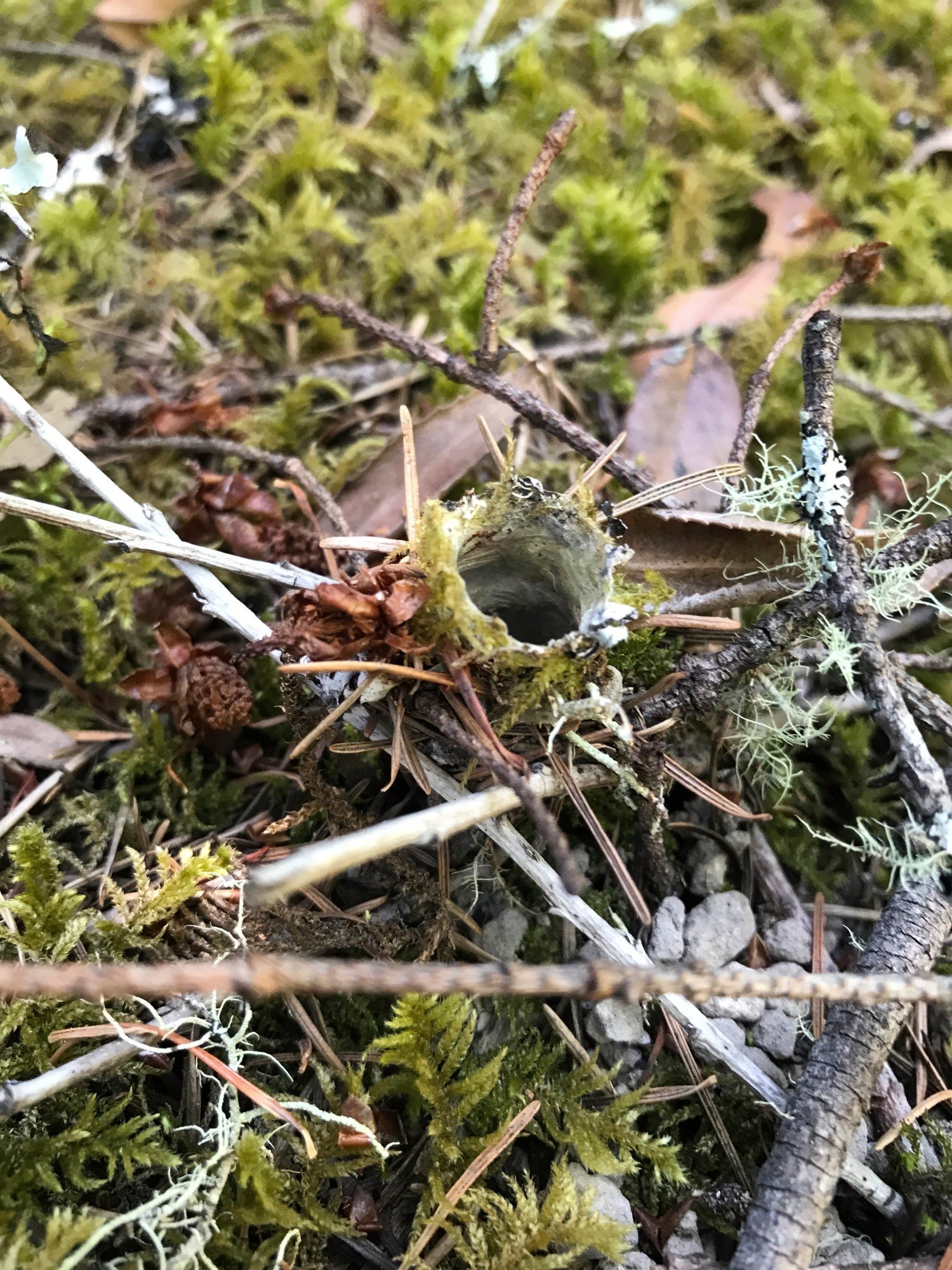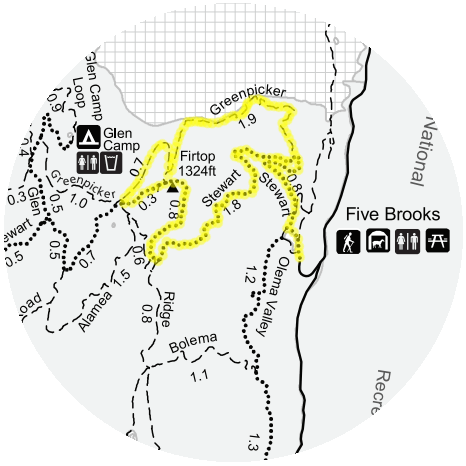Hiking in the shaded forest at Five Brooks
Looking to escape the summer heat? The forested trails off the Five Brooks Trailhead offer shade and serenity. On the last day of July, I headed for Five Brooks to hike the Greenpicker Trail by way of the Stewart Trail. From the Five Brooks trailhead, I walked past the Mill Pond remembering the lucky time I saw wood duck babies fledging by dropping one at at time from their nest box into the water below. A moment of pure joy and perfect timing — five minutes earlier or later and I would have missed it.
On the Stewart Trail at 9:30am, I was curious to see if the California Spikenard (Aralia Californica) was fruiting yet. Its deep purple berries grow in large round clusters, exploding from the top of the large-leaved shrub like fireworks - very striking. Alas, it was too early in the season and I only saw one plant with dark berries. Prime fruiting is August and September.
As I proceeded along the Stewart Trail, I spotted a single Red Baneberry (Actaea rubra) plant with a cluster of red berries. Red Baneberry is not a rare plant but it’s not widespread in Point Reyes. It’s native to the US and grows in shady areas with moist to wet soil. The ditch running along the edge of the trail provides a perfect moist environment. I’ve only spotted Red Baneberry on a few trails in Point Reyes, but it could be that it’s easiest to spot when it’s fruiting and I’m simply not on other trails at the right time of year. Red Baneberry is poisonous to humans, especially the berries, but not to birds who disperse the seeds. Native Americans have traditionally used the juice from the fruits of various baneberry species to poison arrows and the root was used as an herbal remedy for menstrual cramping. I wonder if this plant was used by the Coast Miwok?
You may have noticed that the Red Baneberry berries look dusty. You will see a layer of dust covering all plants along the early part of the Stewart Trail which is, in fact, a gravel road. You will also find horse poop everywhere along the trail since Five Brooks Ranch offers horseback riding and the horse camp is nearby. The poop is my least favorite thing about the trail and is especially unwelcome on windless days when the smell lingers. Otherwise, I love this trail.
Less than a mile along the Stewart Trail, I arrived at the intersection with the Greenpicker Trail (about 10:20am). I was pleased to see the trail did not have a warning sign about yellow jackets! The Greenpicker Trail travels deep into the forest and offers lovely peeks of the Bolinas Ridge along the way. It’s uphill coming from this direction so my pace was even slower than usual. This trail is most beautiful in late winter or spring when the Red Elderberry trees and seasonal flowers are blooming. It’s one of my favorite trails in Point Reyes. I heard several birds along the trail which Merlin identified as a Purple Martin, Red-tailed Hawk, Osprey, and a Sharp-shinned Hawk. I enjoyed the trail so much I decided to continue on a segment that heads toward Glen camp and Wildcat camp (at about noon). I discovered a small, dead Pacific Wren (Troglodytes pacificus) in the middle of the trail. I gently moved it to the trail side so it wouldn’t get stepped on, covered it with a leaf shroud, and shared my sorrow for its demise. It didn’t look injured and I wondered how it had died. Encountering dead or injured beings is an inevitable, but sad, part of hiking.
This segment of the Greenpicker was covered with Veldtgrass (Ehrharta erecta) growing into the trail. It’s an invasive plant that is prolific along Point Reyes trails and gets mowed occasionally by the trail crews along with the other overgrown grasses. Doug firs that looked to be the same age were spaced enough so that sun could light the forest. The filtered sunlight was beautiful. At the trail sign for Glen Camp, I turned left onto an unmarked trail that went about 50 feet up to the Stewart Trail near the intersection with the Ridge Trail. I hiked uphill on the Stewart Trail to Firtop where I stopped for lunch at the meadow on the hill top. To get to the meadow, follow the unmarked path slightly uphill a short distance where you’ll see two places to tie horses. A swallowtail butterfly circled the meadow the whole time I ate lunch. It seemed to be on a continuous loop. I wondered why it stuck to the same circuit for such a long time. Was it looking for a mate or for food? Why did it not travel farther away? For a wild moment, I wondered if someone had flipped a switch to cue a fabricated natural environment for me. It made me very happy to watch the butterfly while I ate.
I left Firtop about 1:30pm and headed down the Stewart Trail for another two hours back to the trailhead. The Stewart Trail is a wide gravel road that’s open for biking and horses in addition to hiking. The park service drives on the road to service the nearby camps. It’s easy to hike on the road since it’s mostly level with a pothole here and there, although you have to keep your eyes on the road to avoid stepping in horse poop. It’s wide enough to allow a group to hike together. The Douglas firs and ferns surrounding the trail are lovely and it’s shaded but light filters through which is glorious in winter. Admiring the towering firs covered in hanging moss, I wondered why their lower branches break off? Doing some quick research, I found these explanations: 1) Because Douglas fir is a fast growing tree, all new growth is relatively weak and susceptible to breakage. 2) The lower branches die when they become too heavily shaded. The moss covered stubs are a reason these trees are so beautiful. I will continue learning about them. Here’s what the park service says briefly about Douglas Firs at Point Reyes.
Along the mostly-shaded trail where the banks are often moist, I spotted an area rich in the silk tunnel burrows of the California Turret Spider (Atypoides riversi). Be warned, once you start looking for these ingeniously camouflaged burrows in the ground, it will be hard to stop. Your hike will grind to a snail’s pace. This is exactly what happened to me. I expected to see burrows on the Greenpicker Trail but the grasses were too high to easily spot them. I was thrilled to find them on the mossy banks of the Stewart Trail. Once you find one turreted burrow, look around to see how many others you can find in the area. The baby spiders don’t go far from home to make their own burrows. I saw as many as 9 turrets within a few feet, and in total, I observed more than 20 burrows within 20 minutes (including stopping, photographing, and looking carefully.) I’m sure there were many more burrows that I missed. The silk turret openings are cleverly masked using debris in the area such as fir needles, lichen, moss, sticks and more. They are most easily spotted against the background of green moss. The spiders need an area that stays moist and cool all year since they are susceptible to drying out and they never leave their burrow. Read more about these fascinating spiders in my news post Home alone with the California Turret Spider. My new question is: Do California Turret Spiders outgrow their homes and make new ones or do they enlarge their home as they grow? The difference in size of the turrets can vary greatly.
After forcing myself to stop looking for spiders, I had a pleasant hike back to the trailhead. I saw several Western Chipmunks (Genus Neotamias), bumble bees, and a Western Fence Lizard (Sceloporus occidentalis) - the only reptile I saw the whole day. I spotted some holes in the bank but they looked too small for the Point Reyes Mountain Beaver. All the butterflies in my path were too fast for my camera. I saw a couple of hikers on the Greenpicker and another half dozen on the Stewart Trail. Toward the end, I passed a group of horseback riders and winced knowing I’d have to traverse the poop trail left in their wake. My attitude improved when I got a friendly “hello” from all the riders.
I highly recommend this route which you will hike much faster than I did! It’s an 8 mile loop.
Stewart-Greenpicker Loop (8 miles)
Starting at the Five Brooks Trailhead:
Hike a short distance along the Mill Pond to the intersection with the Olema Valley Trail (going left) and Stewart Trail (going right) (0.3 miles)
Take the Stewart Trail to the Greenpicker Trail (1.0 mile)
Hike the Greenpicker Trail to the split (1.8 miles)
Take the Greenpicker Trail that splits to the right toward Glen camp and Wildcat camp (0.7 miles) - mostly gradually downhill
At the split for Glen camp/Wildcat camp, take the unmarked path to the left to the Stewart Trail (near the Ridge Trail)
Turn left on the Stewart Trail and hike uphill to Firtop (0.3 miles), then continue downhill on the Stewart Trail back to the trailhead (3.9 miles)
Shortcut: At step 6, instead of taking the Stewart Trail to the left toward Firtop, cross over the Stewart Trail to the Ridge Trail (to the right). You’ll pass the Alamea Trail at (0.1 miles) and in another (0.5 miles) the Ridge trail splits with a spur on the left going back to the Stewart Trail (0.1 miles). Turn right and take the Stewart Trail back to the trailhead. This shortcut on the Ridge Trail shaves off 0.4 miles.
A bigger shortcut: Skip the second part of the Greenpicker Trail (0.7 miles) and go directly to the Stewart Trail at Firtop. This saves one mile.
A note on maps: The Five Brooks area is one of the few areas in Point Reyes National Seashore where the park’s otherwise stellar double-sided Hiking Map is lacking in sufficient details such as mileage around the Mill Pond or details for the shortcut above. The other place where the map fails is nearby with the Glen trails which are a warren of small trails on the map. In these cases, I recommend the Bay Area Trail Map of Point Reyes published by Redwood Hikes Press.
NPS hiking map “south” detail of Five Brooks area







